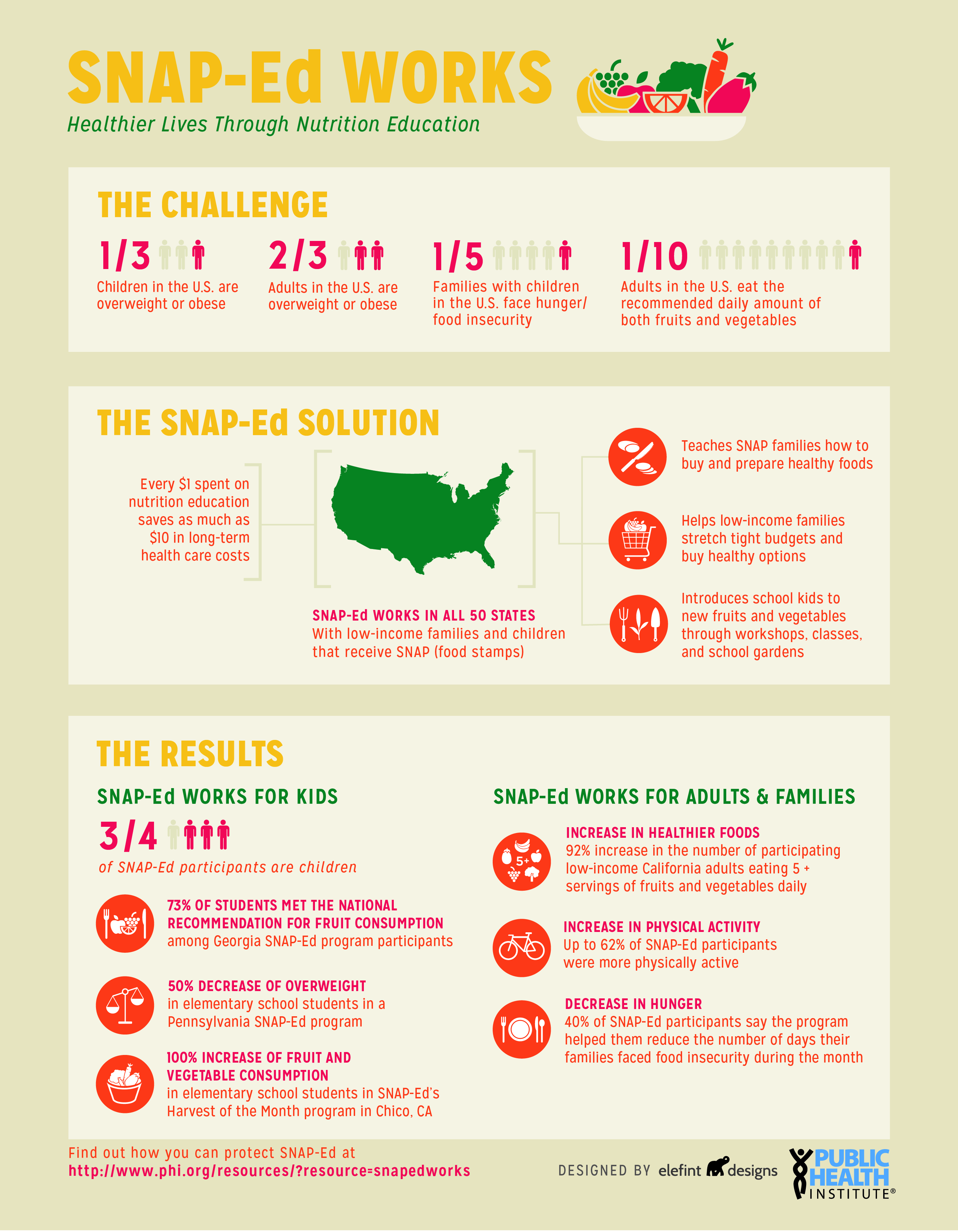
Snap Ed Works
- Public Health Institute
-
Focus Areas
Chronic Disease Prevention, Healthy Communities, Women, Youth & Children -
Issues
Nutrition & Food Security -
Expertise
Outreach & Dissemination, Public Policy Advocacy

1 in 3 children in the US are overweight or obese. Yet at the same time, 1 in 5 families struggle with food insecurity—not knowing from one day to the next whether their families will have enough to eat.
Nationally, SNAP and SNAP-Ed are working hand-in-hand to help support families to eat healthily. SNAP (food stamps) provides families with support in affording food; SNAP-Ed, the nutrition education program, helps SNAP and low-income families find, buy and prepare healthier foods on their limited budgets. From schools, to the YMCA, to farmer’s markets, SNAP-Ed works.
Our new SNAP-Ed infographic illustrates how critical SNAP-Ed is in supporting healthy eating: though it makes up just a fraction of SNAP funding, SNAP-Ed efforts are making a real difference.
References
The Challenge
Ogden, C. L., Carroll, M. D., Kit, B. K., & Flegal, K. M. (2012). Prevalence of obesity and trends in body mass index among US children and adolescents, 1999-2010. JAMA: the journal of the American Medical Association, 307(5), 483-490.
Ogden, C. L., Carroll, M. D., Kit, B. K., & Flegal, K. M. (2012). Prevalence of the Obesity in the United States, 2009–2010. NCHS Data Brief, No. 82, January 2012. Hyattsville, MD: National Center for Health Statistics, http://www. cdc. gov/nchs/data/databriefs/db82, 1-8.
Centers for Disease Control and Prevention. State Indicator Report on Fruits and Vegetables, 2013. Atlanta, GA: Centers for Disease Control and Prevention, U.S. Department of Health and Human Services; 2013. ; Casagrande, S. S., Wang, Y., Anderson, C., & Gary, T. L. (2007). Have Americans increased their fruit and vegetable intake?: The trends between 1988 and 2002. American journal of preventive medicine, 32(4), 257-263.
Coleman-Jensen, A., Nord, M., & Singh, A.. (2013). Household Food Security in the United States in 2012. USDA ERS
The SNAP-Ed Solution
Dollahite, J., Kenkel, D., & Thompson, C. S. (2008). An economic evaluation of the expanded food and nutrition education program. Journal of nutrition education and behavior, 40(3), 134-143.; Lambur, M. T. (1999). Applying cost benefit analysis to nutrition education programs.
The Results
FY 2011 Education and Administrative Reporting System (EARS) Data, Supplemental Nutrition Assistance Program, Food and Nutrition Service, U.S. Department of Agriculture
Program impact report,HealthMPowers, Inc
Foster, G. D., Sherman, S., Borradaile, K. E., Grundy, K. M., Vander Veur, S. S., Nachmani, J., … & Shults, J. (2008). A policy-based school intervention to prevent overweight and obesity. Pediatrics, 121(4), e794-e802.
Center for Nutrition and Activity Promotion (CNAP), CSU, Chico, 2013
Sugerman, S., Foerster, S. B., Gregson, J., Linares, A., & Hudes, M. (2011). California adults increase fruit and vegetable consumption from 1997-2007.Journal of Nutrition Education and Behavior, 43(4), S96-S103.
Sexton, J. S. (2013). Supplemental nutrition assistance program-education (SNAP-Ed) through the land-grant university system for FY 2010: A retrospective review. Starkville, MS.
Ibid
Work With Us
You change the world. We do the rest. Explore fiscal sponsorship at PHI.
Support Us
Together, we can accelerate our response to public health’s most critical issues.
Find Employment
Begin your career at the Public Health Institute.



